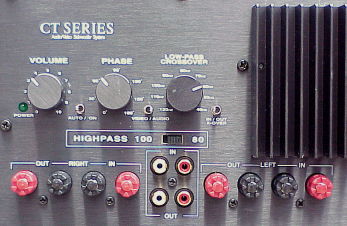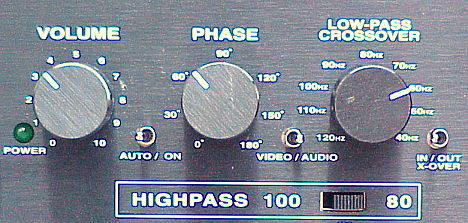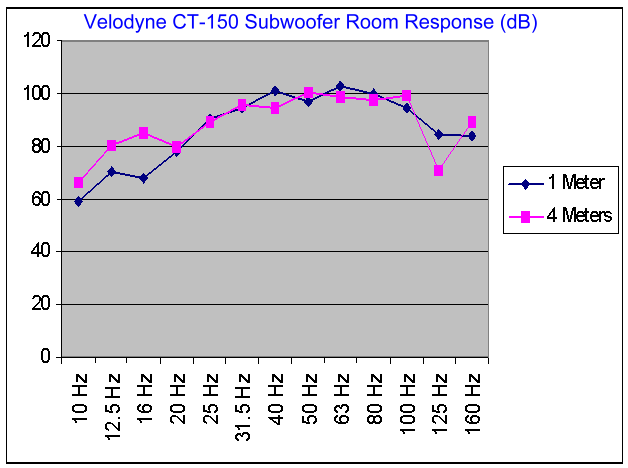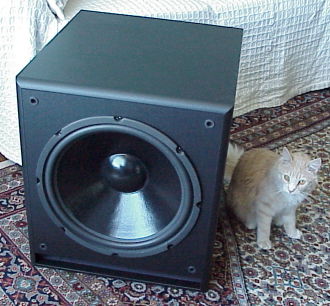Product Review - Velodyne
CT-150 15" Powered Subwoofer -
July, 1999
John E. Johnson, Jr.
![]()
|
Velodyne CT-150 15" Powered Subwoofer 15" Forward Firing Driver, 6 Pound Magnet 250 Watt rms A/B Amplifier, Line-Level and Speaker-Level Inputs and Outputs MFR: 23 Hz - 120 Hz � 3 dB High Pass: 80 Hz or 100 Hz, 6 dB per Octave Low Pass: 40 Hz - 120 Hz, 12 dB per Octave Variable Phase Control, 00 - 1800 Size: 21"H x 18 1/2"W x 20"D Weight: 72 Pounds MSRP: $799 USA (Street Price $700) |
| Velodyne Acoustics, Inc., 1070 Commercial Street, Suite 101, San Jose, California 95112; Phone 408- 436-7270; Fax 408-436-7276; E-Mail [email protected]; Web http://www.velodyne.com. |
Introduction
Some years ago, when I first considered buying a subwoofer, and I looked at Velodyne, they only had a few models to choose from. They were downward firing and expensive (but worth it). That was before home theater was such a big thing. Now that just about everyone is interested in watching movies at home, and we all want to reproduce the experience we have at the commercial theater more or less (excluding the sticky floors), a subwoofer is critical to our audio system. However, not everyone can afford, or even wants to spend mucho bucks, on a sub. Velodyne has taken their time about coming up with mass market products, in part because they have long been one of the most highly respected names in the subwoofer business. Their latest series, called CT, represents quite an achievement.
So, show me . . .
The CT series has four models: CT-80, CT-100, CT-120, and CT-150, with the respective drivers 8", 10", 12", and 15" in diameter. The CT-150 has a 250 watt rms A/B amplifier with current sensing feedback from the driver voice coil (2 1/2"). Velodyne's top of the line subs use a solid state accelerometer mounted on the voice coil. Current sensing feedback is less accurate than servos, but it is also less expensive. Current sensing feedback works by knowing what the current is that is being fed to the voice coil by the amplifier, and sensing what the current is that is being generated by the actual voice coil movement within the gap of the magnet. The difference in the waveforms between the amplifier feed and the voice coil generated current (this difference represents distortion) is inverted and fed back into the amplifier. This cancels out much of the distortion produced by inaccurate movement of the driver cone. The CT-150 is the only member of the CT series that has current sensing feedback. It is also the only one that has a variable phase control. The others have selectable 00 or 1800. One should remember that phase adjustment really only matches the phase of the sub and the main speakers at one frequency, because the phase alignment changes as one moves away from the selected frequency (called phase shift). However, variable phase can be helpful, and I found the most pleasing sound when the phase was set around 600.
 |
 |
The rear panel of the CT-150 looks more like a $2,000 subwoofer than a $799 one. It has just about every type of control that one could want. Starting on the left, there is a rotary volume control, followed by an auto/on toggle switch (auto-on sensor for when you don't want to reach behind the sub and turn it on manually), then a rotary phase control, video/audio toggle (alters the response curve for use with movies or music), variable low-pass rotary control (40 Hz - 120 Hz), and low-pass crossover in/out toggle (for use with receivers and preamps that control the low-pass output into subwoofers). Below the rotary controls is a slider switch for selecting the high-pass frequency (either 80 Hz or 100 Hz). At the bottom of the panel are speaker binding posts for speaker-level inputs and outputs. These posts have a plastic insert to meet the European electrical code. I imagine that a good pair of needle nosed pliers could be used to remove them for American use with banana plugs. In between the binding posts are RCA jacks for line-level input and output (the speaker-level and line-level outputs are high-passed at the slider switch selected frequency).
The panel is made of brushed aluminum, and the enclosure covering is a matte black vinyl. The vinyl is on all sides, including the bottom. Nice touches from a fine company. Four rubber feet are included if you want to stick them on. If you are putting the sub on a rug, the feet are not necessary. On wooden floors, or other types of hard surfaces, use the feet.
I tested the CT-150 in our reference audio system, which includes an Audio Alchemy CD package, Audio Electronic AE-1 Tube Preamplifier, White Audio B-80 Monoblock Power Amplifiers, Monitor Audio Studio 20 SE Tower Speakers, and Nordost Cables. I also put the CT-150 into my home theater reference system, which includes a Yamaha DVD-S700 DVD Player, Yamaha DSP-A1 Preamp/Amplifier, Krix Speakers, and Nordost Cables.
One of the problems with all subwoofers is blending the bass with the sound from the other speakers. Although a variable phase control is not a panacea, it does help. I played some of my favorite CDs, including Natalie Cole's "Unforgettable", and adjusted the phase setting until it sounded "right". SPL meters are fine, but nothing beats the ears for the most significant test. As with other subwoofers, I found a low-pass setting of 60 Hz desirable. I have listened to these CDs so many times, I know exactly when a subwoofer or main speaker is adding chesty harmonics. What surprised me most about this subwoofer is that it is so clean and tight. No boominess or chestiness (two things that are extremely irritating to hear). Each deep note is musically distinguishable. There is also an uncanny amount of dynamics, meaning that it has punch (responds quickly), which is unusual in a 15" driver. This product has obviously been very, very carefully engineered. The slot loading (like a "port" but with a rectangular shape instead of being round) plays a big role here. The wind coming out of the slot moved the tassles on my rug several feet away. 250 watts of amplification sounds like a big number, but at a time when companies are putting class D amplifiers (digital switching amplifiers) in subs, with 400 watts, 1000 watts, and more, a 250 watt amp is modest. However, it appears to be sufficient here, and, at $799, appropriate. The CT-150 has clipping protection circuitry that prevents the amplifier from being overdriven, and this feature seemed to work nicely. Although I could hear the amplifier reaching its limits with the sine waves, and the heat sinks got very warm, I could not get the driver to "pop" like I can with amplifiers that don't have clipping protection. In the long run, clip protection will make life easier on the driver.
In the home theater lab, the CT-150 was more than apt. Bass is kind of a funny thing in audio. There can be lots of distortion, and some people will like it. Nothing wrong with that. Having fun and feeling good is what it's all about. However, the CT-150 is not one of those kinds of subwoofers. It produces powerful deep bass, but because harmonics are not a big part of its profile, there can be sounds that you feel and not hear, as opposed to hearing bass all the time with subs that produce lots of harmonics. For example, the lunch scene in "Jurassic Park" has some extremely deep sounds. With a subwoofer that has significant harmonics, the crunching sounds will seem more powerful than they actually are. I prefer clean bass, which is what the CT-150 produces. It won't play as loud as the Velodyne HGS-18, but within its range of power, the CT-150 sounds like a much more expensive product. Plus, it has all the features on the amplifier panel that just about any subwoofer possibly could.
Following is a chart that summarizes the room response test to sine waves at various frequencies. The tests were measured with the low-pass set to 120 Hz, the crossover switch set to "in", the Audio/Video switch set to "Audio", and the phase set to 1200. The grille was off during the tests. The volume was set to 90 dB at 25 Hz, and then the other frequencies were measured relative to that setting.

I obtained 105.6 dB maximum output at 31.5 Hz, before clipping, measured at 1 meter. As you can see, the response is pretty flat in the 25 Hz - 100 Hz range. The 125 Hz dip at 4 meters is a room effect.
In summary, the Velodyne CT-150 is a killer product. It sets new standards in the $500 - $1,000 range subwoofers, and is a definite must on the list of items to audition.
John E. Johnson, Jr.
![]()
� Copyright 1999 Secrets of Home Theater
& High Fidelity
Return to Table of Contents for this Issue.


